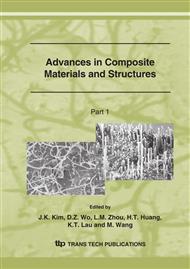p.717
p.721
p.725
p.729
p.733
p.737
p.741
p.745
p.749
In Situ Crosslinking Induced Structure Development and Mechanical Properties of Nano-Silica/Polypropylene Composites
Abstract:
In our previous works, a double percolation mechanism of stress volumes was proposed to explain the special effects generated by small amounts of grafted nanoparticles. Accordingly, it is inferred that strengthening nanoparticle agglomerates and enhancing nanoparticles/polymer matrix interfacial interaction are the key issues to improve mechanical performance of the matrix polymer. To confirm this idea, in-situ crosslinking was adopted to prepare nanocomposites by adding reactive monomers and crosslinking agents during melt compounding of nano-silica with polypropylene (PP). It was found that the grafted polymer chains were successfully crosslinked and chemically bonded to the nano-silica forming crosslinked networks. Meanwhile, matrix molecular chains penetrated through the networks to establish the so-called semi-IPN structure that interconnected nanoparticles by the networks and improved filler/matrix interfacial interaction. As a result, the tiny nanoparticles were well distributed in the matrix and the toughening and reinforcing effects of the nanoparticles on the matrix were brought into play at rather low filler loading, as evidenced by mechanical performance tests. Besides, β-crystal was detected in the nanocomposites experienced in-situ crosslinking reaction.
Info:
Periodical:
Pages:
733-736
Citation:
Online since:
March 2007
Authors:
Keywords:
Price:
Сopyright:
© 2007 Trans Tech Publications Ltd. All Rights Reserved
Share:
Citation:


